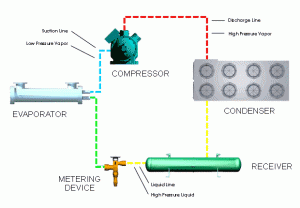 Master mechanical refrigeration cycle basics in five simple steps
Master mechanical refrigeration cycle basics in five simple steps
August 25, 2014 REDWIRE is news you can use from leading suppliers. Powered by FRASERS.
Posted by Berg Chilling Systems Inc
Berg Chilling Systems is a global leader in custom thermal management solutions. For over 35 years in more than 50 count... Read more
Subscribe
Free REDWIRE e-newsletter

How does a nice warm bowl of ice cream for dessert sound? Or perhaps you would prefer a lukewarm cup of jello instead? Neither? Didn’t think so.
Proper refrigeration of perishable food and food products is vital to ensure that the preservation of taste, freshness, and more important, safety, remain at a consistently high quality.
Keep cool under pressure when it comes to understanding this simplified five-step version of household and industrial refrigeration. For a more in-depth explanation of the refrigeration cycle, contact Berg Chilling System Inc.
The purpose of the refrigeration cycle is to transfer heat from one component into another.
Typical refrigeration system components include:
1. The Compressor
The compressor is the main mechanism of a refrigerator circulating refrigerant (a cooling substance) throughout the system at various pressures and flow rates.
Refrigerant is recycled and reused throughout because refrigerators are a closed system.
While refrigerant passes through the entire refrigeration cycle at various temperatures, the benefit to closed systems reduced contamination and regulated flow of refrigerants, which changes from liquid, to gas and vapour depending where in the cycle it is in. At the compressor stage, the refrigerant is in a vapour state.
Since the compressor follows the evaporator within the refrigeration cycle, the vapour is at a higher temperature, which now needs to be removed of heat. In order to achieve this goal, the compressor releases the refrigerant vapour to the condenser.
2. The Condenser
At this stage, the refrigerant vapour temperature is elevated compared to the cooler ambient air (for air-cooled type refrigerants) or the surrounding water (for water-cooled type refrigerants) that passes through the condenser.
3. The Receiver
A common component of a refrigeration system, the receiver temporarily holds excess refrigerant and recruits this liquid from the condenser when conditions require an increase of refrigerant at various stages of the cycle and at various times within the refrigeration system.
4. The Metering Device
A refrigeration metering device is either a thermal expansion valve, capillary tube or an alternative device controlling the refrigerant flow into the evaporator. Pegged as the actual starting point in the refrigeration cycle, the metering device
Liquid refrigerant passes through the small opening of the metering device, triggering a drop in both pressure and temperature. As the refrigerant enters into the evaporator, the evaporation process already starts to take place.
5. The Evaporator
Also referred to as the cooling coil, the evaporator continues the evaporation by removing heat from the expanded refrigerant, which triggers the refrigeration cycle to go back full circle.
Share
Posted by Berg Chilling Systems Inc
Berg Chilling Systems is a global leader in custom thermal management solutions. For over 35 years in more than 50 count... Read more